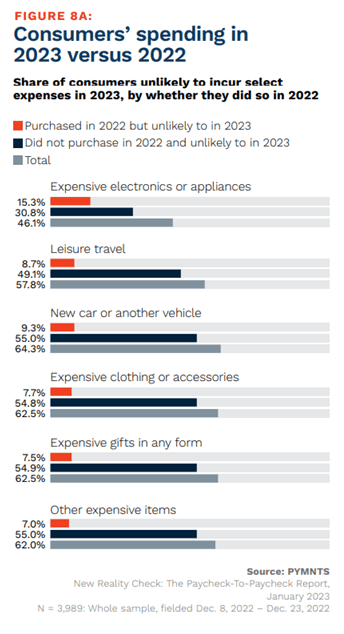42% of Consumers Trade Other Luxuries for Travel
This installment of PYMNTS’ miniseries based around consumer spending patterns focuses on the travel sector.
Getting away from it all has been one of the last discretionary items consumers are forgoing in their ongoing battle to combat inflation. This reluctance highlights the importance of travel on the consumer mindset, as travel is typically a huge expense no matter the general economic landscape. Nevertheless, the majority of consumers are either planning on cutting out leisure travel this year or already did so last year and have no plans to restore it. This sentiment is detailed in the January PYMNTS collaboration with LendingClub, “New Reality Check: The Paycheck-to-Paycheck Report.”

As the chart illustrates, 58% of consumers self-identified as unlikely to purchase travel in 2023, including 9% who had purchased travel last year. This dimming outlook on travel is coming as a blow to the airline industry, which has so far maintained optimism toward 2023 despite this past season’s air travel chaos. Betting on the same post-pandemic wave propelling travel in 2022, ticket prices have been climbing as much as 40% year over year.
The hotel sector has also shared a similar positive outlook on leisure travel, as hotel room bookings are finally approaching or in some cases eclipsing pre-pandemic levels. It is this demand that led Mark Hoplamazian, chief executive of Hyatt Hotels, to recently comment, “Leisure is showing no signs of slowdown whatsoever.”
This sentiment has so far borne out. Additional PYMNTS research has found that the 14% rise in consumers using digital tools overall has largely been driven by travel and transportation-related apps and platforms. Specifically, 16% more consumers are checking online travel information, with the share purchasing airfare digitally also up 16% from the same time last year. Call it the “great escape” if you will, as consumers’ craving for escape from everyday headaches has led to a double-digit increase in experience spending this past February.
However, rumblings of the shaky status of online travel stocks may mean the sector is seeing the same cost-cutting that plagues other discretionary spend categories, as the ripple effects of increased interest rates take hold. This uncertainty may have partially been a driver behind Google’s rollout earlier in April of its airfare price guarantee program, with any cost differences redeemable through Google Wallet.
Alternative payment methods such as buy now, pay later may give some consumers a bit of breathing room when it comes to paying off a vacation, but some travelers are staying home this year to cut costs. Should consumers’ reluctance to forgo the annual getaway be any indicator, though, travel may rebound when some stability returns to the economic landscape.

